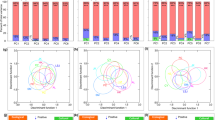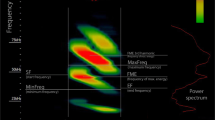Abstract
We examined the intra-individual variation in resting frequency of the constant-frequency component of the second harmonic of the pulse (F rest) over 4 years in a laboratory colony of the Taiwanese leaf-nosed bat (Hipposideros terasensis). Patterns of change in F rest were observed when individuals were added to or removed from the colony so that we investigated whether F rest was affected by neighboring colony members. F rest of each bat continually showed a long-term gradual change throughout the year, and all bats in the colony increased or decreased their F rest in the same direction as a group non-seasonally. The greatest short-term changes were observed when new bats with a relatively low F rest joined the colony and F rest of new bats converged with those of the original colony members around 8 –16 days after their introduction. Conversely, a single individual showed sudden short-term decrease in F rest after its isolation from other colony members. These findings strongly indicate that F rest is flexible according to the presence of neighboring conspecific bats. We suggest that the audio-vocal feedback for conspecific pulses appears to be involved in the short- or long-term intra-individual variation in F rest other than factors previously thought such as age or season.







Similar content being viewed by others
References
Boughman JW (1998) Vocal learning by greater spear-nosed bats. Proc R Soc Lond B 265:227–233
Boughman JW, Wilkinson GS (1998) Greater spear-nosed bats discriminate group mates by vocalization. Anim Behav 55:1717–1732
Gaioni SJ, Riquimaroux H, Suga N (1990) Biosonar behavior of mustached bats swung on a pendulum prior to cortical ablation. J Neurophysiol 64:1801–1817
Guillén A, Juste BJ, Ibáñez C (2000) Variation in the frequency of the echolocation calls of Hipposideros ruber in the Gulf of Guinea: an exploration of the adaptive meaning of the constant frequency value in rhinolophoid CF bats. J Evol Biol 13:70–80
Gustafson Y, Schnitzler HU (1979) Echolocation and obstacle avoidance in the hipposiderid bat Assellia tridens. J Comp Physiol 131:161–167
Esser KH (1994) Audio-vocal learning in a non-human mammal: the lesser spear-nosed bat Phyllostomus discolor. Neuroreport 148:1718–1720
Habersetzer J, Schuller G, Neuweiler G (1984) Foraging behavior and Doppler shift compensation in echolocating Hipposiderid bats, Hipposideros bicolor and Hipposideros speoris. J Comp Physiol A 155:559–567
Henson OW Jr, Koplas PA, Keating AW, Huffman RF, Henson MM (1990) Cochlear resonance in the mustached bat: Behavioral adaptations. Hear Res 50:259–274
Hiryu S, Katsura K, Lin LK, Riquimaroux H, Watanabe Y (2005) Doppler-shift compensation in the Taiwanese leaf-nosed bat (Hipposideros terasensis) recorded with a telemetry microphone system during flight. J Acoust Soc Am 118:3927–3933
Huffman RF, Henson OW Jr (1993a) Labile cochlear tuning in the mustached bat, I. Concomitant shifts in biosonar emission frequency. J Comp Physiol A 171:725–734
Huffman RF, Henson OW Jr (1993b) Labile cochlear tuning in the mustached bat, II. Concomitant shifts in neural tuning. J Comp Physiol A 171:735–748
Jones G (1999) Scaling of echolocation call parameters in bats. J Exp Biol 202:3359–3367
Jones G, Ransome RD (1993) Echolocation calls of bats are influenced by maternal effects and change over a lifetime. Proc R Soc Lond B 252: 125–128
Jones B, Gordon T, Nightingale J (1992) Sex and age differences in the echolocation calls of the lesser horseshoe bat, Rhinolophus hipposideros. Mammalia 56:189–193
Jones G, Morton M, Hughesand PM, Buden RM (1993) Echolocation, flight morphology and foraging strategies of some West African hipposiderid bats. J Zool Lond 230:385–400
Jones G, Sripathi K, Waters DA, Marimuthu G (1994) Individual variation in the echolocation calls of three sympatric Indian hipposiderid bats, and an experimental attempt to jam bat echolocation. Folia Zool 43:347–361
Ostwald J (1984) Tonotopical organization and pure tone response characteristics of single units in the auditory cortex of the greater horseshoe bat. J Comp Physiol A 155:821–834
Pearl DL, Fenton MB (1996) Can echolocation calls provide information about group identity in the little brown bat (Myotis lucifugus)? Can J Zool 74:2184–2192
Pye JD (1972) Bimodal distribution of constant frequencies in some hipposiderid bats (Mammalia: Hipposideridae). J Zool Lond 166:323–335
Riquimaroux H, Watanabe Y (2002) Characteristics of bat sonar sounds recorded by a telemetry system and a fixed ground microphone. Proc WESTPRACVII 233–238
Riquimaroux H, Gaioni SJ, Suga N (1992) Inactivation of the DSCF area of the auditory cortex with muscimol disrupts frequency discrimination in the mustached bat. J Neurophysiol 68:1613–1623
Schnitzler HU (1968) Die Ultraschallortungslaute der Hufeisen-Fledermaüse (Chiroptera-Rhinolophidae) in vershiedenen Orientierungssituationen. Z Vergl Physiol 57:376–408
Schuller G (1980) Hearing characteristics and Doppler shift compensation in South Indian CF-FM bats. J Comp Physiol A 139:349–356
Schuller G, Beuter K, Schnitzler HU (1974) Response to frequency shifted artificial echoes in the bat Rhinolophus ferrumequinum. J Comp Physiol 89:275–286
Simmons JA (1974) Response of the Doppler echolocation system in the bat, Rhinolophus ferrumequinum. J Acoust Soc Am 56:672–682
Suga N (1984) The extent to which biosonar information is represented in the bat auditory cortex. In: Edelman GM, Gall WE, Cowan WE (eds) Dynamic aspect of neocortical function. Wiley, New York, pp 315–373
Suga N, Niwa H, Taniguchi I, Margoliash D (1987) The personalized auditory cortex of the mustached bat: Adaptation for echolocation. J Neurophysiol 58:643–654
Acknowledgments
We would like to thank Dr. Kyle Armstrong for substantial suggestions, and two anonymous reviewers for helpful and precious comments in this manuscript. This work was supported partly by a grant to RCAST at Doshisha University from MEXT of Japan, Special Research Grants for the Development of Characteristic Education from the Promotion and Mutual Aid Corporation for Private Schools, Japan, and the Innovative Cluster Creation Project promoted by MEXT. The experiments comply with the “Principles of animal care”, publication No. 86–23, revised 1985 of the National Institute of Health, and also with current Japanese laws.
Author information
Authors and Affiliations
Corresponding author
Rights and permissions
About this article
Cite this article
Hiryu, S., Katsura, K., Nagato, T. et al. Intra-individual variation in the vocalized frequency of the Taiwanese leaf-nosed bat, Hipposideros terasensis, influenced by conspecific colony members. J Comp Physiol A 192, 807–815 (2006). https://doi.org/10.1007/s00359-006-0118-5
Received:
Revised:
Accepted:
Published:
Issue Date:
DOI: https://doi.org/10.1007/s00359-006-0118-5




